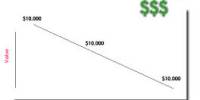Volatility arbitrage is a financial arbitrage technique that is directly dependent on and based on volatility. It is a trading strategy that seeks to profit from the difference between an asset’s forecasted future price volatility, such as a stock, and the implied volatility of options based on that asset. It denotes a type of statistical arbitrage strategy used in options trading. Profits are generated by the difference between the implied volatility of options and the expected volatility of underlying assets.
Volatility arbitrage involves several risks, including the timing of holding positions, potential asset price changes, and the uncertainty in the implied volatility estimate. The goal is to profit from differences between the option’s implied volatility and a forecast of future realized volatility of the option’s underlying. Volatility, rather than price, is used as the unit of relative measure in volatility arbitrage, with traders attempting to buy volatility when it is low and sell volatility when it is high.
Overview
Volatility arbitrage is a trading strategy that profits from the difference in forecasted future price volatility and implied volatility of options based on an asset, such as a stock. An option contract, to a volatility arbitrage trader, is a way to speculate on the volatility of the underlying rather than a directional bet on the price of the underlying. A trader is said to be long volatility if he purchases options as part of a delta-neutral portfolio. He is said to be short volatility if he sells options.
Buying an option is a bet that the underlying’s future realized volatility will be high, while selling an option is a bet that the underlying’s future realized volatility will be low, as long as the trading is done delta-neutral. Because of the put-call parity, it makes no difference whether the options traded are calls or puts. This is due to put-call parity, which proposes a risk-neutral equivalence relationship between a call, a put, and some amount of the underlying. As a result, holding a delta-hedged call yields the same returns as holding a delta-hedged put.

Arbitrage based on volatility is not “true economic arbitrage” (in the sense of a risk-free profit opportunity). It is based on predicting the direction of implied volatility in the future. Even portfolio-based volatility arbitrage strategies that seek to “diversify” volatility risk may encounter “black swan” events when changes in implied volatility are correlated across multiple securities and even markets. Long Term Capital Management employed the volatility arbitrage strategy.
A volatility arbitrage strategy can be carried out using a delta-neutral portfolio comprised of an option and its underlying asset. Assume a trader believes a stock option is underpriced because implied volatility is too low. To profit from that forecast, they may open a long call option combined with a short position in the underlying stock. If the stock price does not change and the trader is correct about implied volatility rising, the option’s cost will rise.
Forecast volatility
To engage in volatility arbitrage, a trader must first forecast the future realized volatility of the underlying. This is typically accomplished by computing the underlying’s historical daily returns for a given past sample, such as 252 days (the typical number of trading days in a year for the US stock market). Other factors, such as whether the period was unusually volatile or if unusual events are expected in the near future, may also be used by the trader to adjust his forecast. For example, if the current 252-day volatility for a stock’s returns is calculated to be 15%, but it is known that an important patent dispute will likely be settled in the next year and will affect the stock, the trader may decide that the appropriate forecast volatility for the stock is 18%.
















